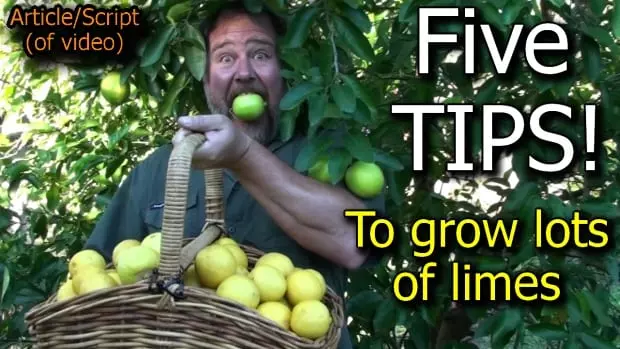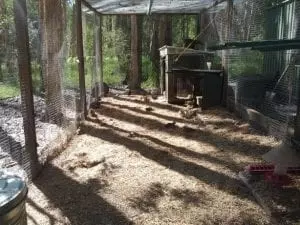Lately, I have been sent several requests by viewers of my YouTube Channel to "transcribe" some of my more popular videos so they can be read (for various reasons, including those who have difficulty understanding spoken English). This article/transcription is on Five Tips on How to Grow a Ton of Limes – Organically and the accompanying video is at the end.
Note: This transcription is NOT necessarily verbatim, rather, it's the script I worked off to produce the video and may contain extra information cut from the editing process. In other words, this article/script contains more information on growing lime trees than the final video does.

Introduction
G’day! I’m Mark from Self Sufficient Me and yes I’m back with another “how to grow a ton of video!”
And, I want to give you guys my FIVE TOP TIPS on how to grow a TON of limes.
This Tahitian lime tree produces so many limes year after year that we simply can’t keep up!
It’s about 6 metres tall and that’s about as big as this variety of tree can get – and it’s around 10 years old and apart from the first few years it has produced an abundance of fruit (literally thousands) year after year ever since. What’s more, whilst the main fruiting season is now (winter in the subtropics) it sets fruit all year round so we never go without a lime.
So how does this lime tree do it? Well, let’s just get into it!
Tip # 1 – Position
Where you place your lime tree is extremely important.
Limes trees are a warm climate plant but yes you can grow them all around the world by keeping its growing heritage in mind and ensuring it is positioned in a nice warm spot.
Protect the tree from strong cold winds by growing it in a sheltered position such as behind a wall that gets a lot of sun or surrounded by a hedge.
Plenty of sun is the key!
Also with respect to positioning is SOIL… Try to plant your tree where it won’t get water logged. Our tree here is positioned on the higher ground if I planted it down the lower part of our property it would get lots of sun but too much boggy ground would literally drown it as not enough oxygen would get to the roots.
Lime trees don’t need perfect soil they are very hardy, however, like most fruit trees limes won’t tolerate growing in prolonged wet/boggy ground. Your lime will cope with a few weeks of wet feet due to an untypical rainy spell but if that ground is prone to staying sodden for weeks after then that’s not good and it would be better to move it particularly if you see signs of oxygen depletion like leaf drop or yellowing.
Our soil is not ideal at all. We have a thin layer perhaps only 6 inches in places of unfertile topsoil and then it hits clay. Nevertheless, this lime is flourishing because of the position and post planting care of the soil.
The best soil for a lime tree is crumbly free draining fertile soil with plenty of organic matter that does hold water but doesn’t stick together when squeezed like clay does rather it can make a clump but still falls apart easily even when wet.
In reality, you don’t have to have perfect soil and if your soil is just "ok" not too heavy and not too sandy/light then even if it’s not very fertile your tree should grow well if you look after it post-planting.
If your soil is straight clay then consider mounding up with some good soil and plant the tree on the mound. If your soil is very sandy consider digging in a heap of compost and good organic soil about a yard in diameter and a foot deep to get your tree off to a great start.
What about pots – you say? Go for it! A nice big pot 40 litres or more with a good potting mix in a warm sunny position with regular water and it will thrive!
Tip # 2 Water
I know I’ve already talked about water but it’s still worthy of being a tip on its own.
Appropriate water at the best time is one of the keys to lots of good quality produce.
Nature has inbuilt clever ways to ensure the best chance of survival and lime trees are no exception. If your tree doesn’t get enough water during flowering and initial fruit set it will worry that it may not have the resources to support much fruit, therefore, it may drop or shed fruit as a survival instinct.
So, keeping in mind what I talked about in tip # 1 in regard to waterlogging – the best way to ensure a lot of fruit and prevent fruit drop is to give the tree extra water during flowering and early fruit set especially if the tree isn’t getting much natural rainfall.
The other time water is important is as the fruit is ripening or starting to swell. You don’t want dry fruit you want juicy plump limes so again if the tree is not getting much natural rainfall and the fruit is beginning to ripen then give it some extra water.
Tip # 3 Pests
Keep pest management minimal.
This might seem counter intuitive but I’m extremely lazy when it comes to pest management and I like to keep it to an absolute minimum and will only spray or use an organic remedy as a last resort if I can see the balance of pests to good guys is beginning to overwhelm the tree – which is very rare.
For example, if I see a few aphids, scale, or leaf miner damage I won’t do anything about it but if most new shoots are covered in these pests then I will spray with an organic mix such as a vegetable oil pest solution mixed with water to smother the animals. Sometimes I may even spot spray with pyrethrum if there are many aphids but never indiscriminately and I never use potent pesticides.
Citrus bugs – I will pick them off by hand and squish them under foot I know some people who use a small hand-held vacuum cleaner to suck them off the tree!
Gall wasp – I don’t use a pesticide but instead I prefer to prune to keep numbers down.
This tree had a nasty attack of a tree borer – I used pruning and a piece of wire stuck in the hole to kill the grub.
Bottom line, your garden needs a few pests to feed the good bugs, the predator insects, and birds so I never panic at the first signs of pests on my tree.
Tip # 4 Trace Elements
Ensure your tree has enough vitamins and minerals (trace elements).
I decided to make trace elements one of my 5 top tips because it’s often overlooked by backyard gardeners and (in my opinion) is the most probable cause of a tree not growing too well. When people add fertiliser they often forget about the other important nutrients lime trees need which are trace elements! Trace elements are the micro nutrients plants need to stay healthy and produce well – think of them as vitamins for humans you don’t need much but it’s important the tree gets them otherwise it will become susceptible to disease and not grow as well as it should.
Citrus trees are particularly vulnerable to lacking trace elements because they originated from areas with specific minerals and soil where other areas around the world may not have them naturally occurring. Therefore, if the lime tree can’t get these micro nutrients from its soil it will suffer and in some cases even die.
Often citrus fertilisers have trace elements in them but many organic fertilisers may not so it’s a clever idea to give the tree a separate dose of general trace elements about once a year or if the tree is showing signs of stress such as yellowing or veiny leaves.
Trace elements can be purchased in a powdered or liquid form – you get get a general mix (like a multivitamin) or more specific elements and they can be applied via a spray for foliage and/or mixed in a watering can to be spread around the base of the tree, usually a dose once a year is enough. Also if you already are a user of seaweed tonic or concentrate (made from seaweed) then giving this to your lime tree instead might provide all the trace elements the tree needs as seaweed is high in many trace elements.
——————————————————————————–
My final tip and in my opinion the most important and the biggest reason why our tree produces so well!
Tip # 5 – Mulching (including fertilising)
Mulch like crazy and fertilise appropriately to replenish the energy lost from production.
Nothing is for free and for my tree to produce so well it needs appropriate food and energy. Not a lot but just enough… Energy from the sun is free and most of the water this tree gets is from rain only but I do need to give it food and I do this via mulch and fertiliser – often these two are the same and that’s why I grouped them together.
Mulching is extremely important especially when the fruit tree is first planted and young because if you get your tree off to a good start if often will grow into a strong tree requiring less nurturing later.
Mulching is where you place organic materials around the tree to suppress weeds and grasses and protect surface feeder roots from the elements such as hot sun, cold nights, and retains soil moisture by slowing down water evaporation.
As mulch breaks down it releases nutrients into the soil which is then used by the tree as food and that’s why I have grouped fertiliser and mulch together with mulching as the main heading because it is a type of fertiliser in my opinion.
Also, with respect to fertiliser, a good mulch acts as a slow release mechanism to trap the fertiliser when it’s sprinkled on top and allow the tree to be fed gradually rather than in one big hit this helps to prevent accidental root burn and over feeding resulting in lots of leafy growth and not much fruit. Furthermore, mulch traps the fertiliser and keeps it where it should be (around the tree) rather than getting washed away in the rain.
So, you can see how important mulching and fertiliser are when you work them together. Remember, for a tree to produce lots of fruit it needs food – you can’t get much out of a fruit tree if nothing is going in… Mulching and fertiliser fixes that.
As far as types of mulch goes, you can use your imagination such as dry grass clippings, straw, leaves, a mixture of small debris like twigs, woodchip, even a mixture of mulch with compost can be very helpful. I often use floor and nesting mulch obtained from our poultry (quail and chicken pens) or even guinea pigs as this is a highly nutritious mix of goodness containing manure doubling as fertiliser.
Speaking of fertiliser, the main types I use are organic fertilisers specific to citrus trees and I add this fertiliser only once a year at the beginning of the main growing season (for most areas including us here in SE QLD the best time is spring).
Conclusion
So there you have it – those were my FIVE TOP TIPS on how to grow a ton of limes!
Position, Water, Pests, Trace Elements, and Mulching (including fertiliser)
Do all those things right and you’ll grow a ton of limes just like I can.
Don’t forget to give this video a thumbs up and share it around – subscribe if you haven’t already and visit my website www.selfsufficientme.com
Thanks for watching, bye for now…
Video – 5 Top Tips for Growing a TON of Limes












